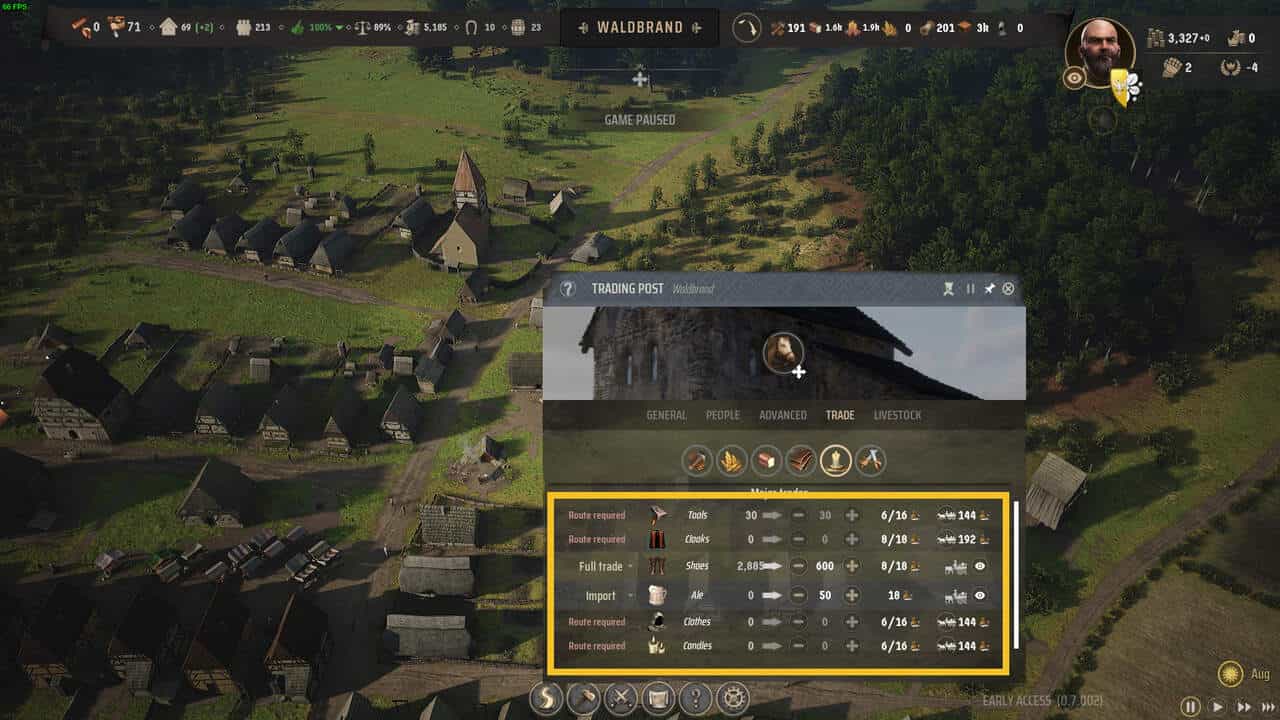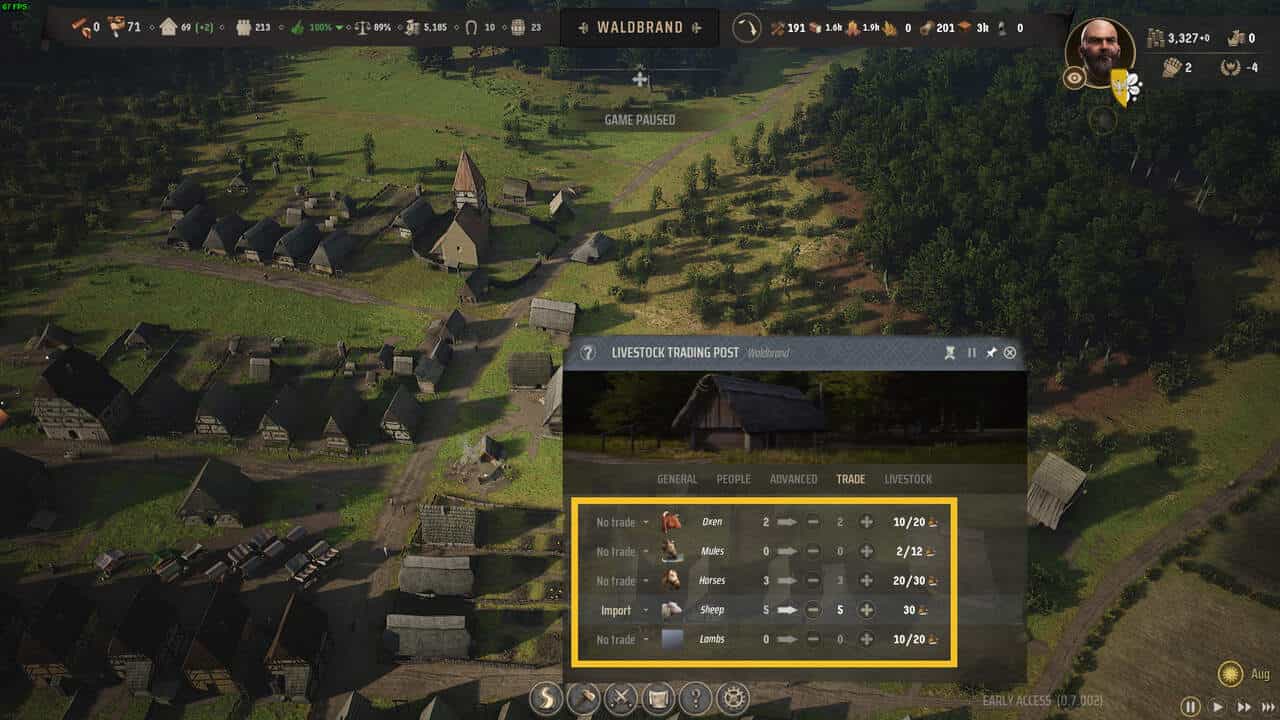Video Gamer is reader-supported. When you buy through links on our site, we may earn an affiliate commission. Prices subject to change. Learn more
- Earn passive Regional Wealth income from level 2 and level 3 burgage plots
- Sell goods at a Trading Post
- Destroy and loot bandit camps
At the start of every Manor Lords game, you’re allocated a small coffer of Regional Wealth. It’s used to buy workshop extensions, livestock, and goods at a trading post. As you set up your early economy and lay down your starting buildings, that stock will quickly dwindle away, forcing you to establish other ways to secure a guaranteed inflow of Regional Wealth. This is done in three ways: passive monthly income from levelled-up burgage plots, trade, and pillaging bandit camps.
As Regional Wealth is used for everything from burgage plot extensions to constructing and upgrading production buildings and establishing trade routes and trading in general, it’s a resource you’ll need throughout a playthrough. We’ll walk you through how to get Regional Wealth in Manor Lords
Regional Wealth is distinct from Treasury, which is your personal wealth used for hiring mercenaries, bribing barons, and constructing settler camps in claimed regions. But, Regional Wealth still has an impact on how much tax you’ll collect, which is a percentage of your Regional Wealth.
How to get Regional Wealth in Manor Lords
There are three ways to get Regional Wealth in Manor Lords:
- Earn passive income from level 2 and level burgage plots
- Export goods at a Trading Post
- Loot destroyed bandit camps
Passive Regional Wealth income from burgage plots
From level 2 onward, every burgage plot generates a set amount of passive Regional Wealth per family, per month as follows:
- Level 2 – 1 Regional Wealth per family, per month.
- Level 3 – 2 Regional Wealth per family, per month.
The per family part is a little confusing as most burgage plots only house a single family. What this refers to is burgage plots with enough land to build an expansion (click on the burgage plot and tap the upgrade button), which will house a secondary family at level 3, therefore doubling that plot’s overall Regional Wealth income.
Upgrading burgage plots has several benefits beyond Regional Wealth generation, namely access to more extension types (artisans from level 2) and space for new citizens (at level 3). But you’ll need to meet and keep up with set requirements related to food variety, clothing, church access, tavern access, and so on to keep your population happy. It’s, therefore, important to have a robust food, commodity, and resource production chain before committing to widespread burgage plot upgrades.

Trade and export goods
The second way to get Regional Wealth in Manor Lords, and arguably, the most profitable, is through trading surplus resources with territories outside of the map. After constructing a Trading Post, you can export excess food, crops, herbs, building materials, commodities like ale, weapons, clothes, and armour to neighbouring fiefdoms, earning Regional Wealth for every trade.
Export prices vary greatly, so concentrate on big ticket items like weapons and commodities to maximise profits. In the early game, you can flog plentiful starter resources known as Minor Trades like planks, hides, and firewood to get the Regional Wealth needed to grow, but always graduate to Major Trade items that serve up better profits in the long-term. These do require that you establish a trade route, which costs Regional Wealth, but the initial investment is quickly recouped and well worth it.

Additionally, you can also build a Livestock Trading Post to sell surplus sheep, cows, horses, lambs, and mules for a hefty profit. This is especially efficient if you have a Sheep Farm and several pastures with the Sheepbreeding development upgrade unlocked, which allows sheep to reproduce automatically, giving you an infinite source of sheep to export. To unlock the upgrade make sure you have a development point (obtained whenever you raise your settlement level), tap your settlement’s name at the top of screen, then choose the Sheepbreeding upgrade represented by a sheep icon.
Destroy bandit camps
Everytime you destroy a bandit camp with your militia, you’ll get a message pop up on screen. Click on it and you’ll have to option to send looted goods and money to your personal Treasury or to the nearest Settlement. Choose the latter and you’re settlement will benefit from a hearty helping on Regional Wealth, typically a few hundred.
How trade and best items to sell
To trade in Manor Lords, you’ll need to build a Trading Post, and depending on the item, establish a trade route (the Trade Logistics Development is worth having to cap trade route costs at 25 Regional Wealth.) Once the Trading Post is built and staffed, tap on Trade then find the item you want to trade and click on Establish a Trade, the horse and carriage icon. Select Export on the left and set the desired surplus, which indicates how much of the item you want permanently stocked in your settlement. Anything above that number will be sold.
Though you can trade dyes, berries, wool, clothes, leather, barley, and any other surplus of good at a Trading Post in exchange for Regional Wealth, certain items command a higher price and are worth prioritising. Leather is particularly easy to produce early on – you only need a source of Hides (Goat Shed extensions or a Hunting Camp). The same goes for Planks, which are produced from Timber by a Sawpit. If you have a surplus of Leather, building one or two Cobbler’s Workshops will turn it into Shoes, which sells for a solid price.
As a final note, Regional Wealth is tied to specific regions rather than the map overall with each region having its own stock and Regional Wealth generation infrastructure. It’s similar to trading and Manor functionality in that sense. Unfortunately, Regional Wealth isn’t transferable between regions and you can’t make a tribute from a wealthy region to a poorer one, for example.



